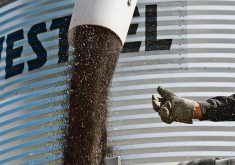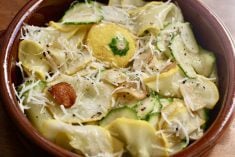We are back home after spending February and March in Mesa, Arizona. This year we took the long way home via Victoria, B.C., to attend the men’s world curling championship.
As we were driving through California, Oregon and the Seattle area of Washington, I began to wonder if this was a wise thing to do. The freeways were so busy and at times it was pouring rain, all making the drive “unrelaxing” to say the least. Bill does the driving and takes it all in stride. I read the map and do the fretting.
Read Also

Alberta cracks down on trucking industry
Alberta transportation industry receives numerous sanctions and suspensions after crackdown investigation resulting from numerous bridge strikes and concerned calls and letters from concerned citizens
Finally we arrived in Victoria and settled in for a week at the rink. The excellent shot making, the excitement of our Canadian team’s many close call games and being part of the rink atmosphere made it all worthwhile.
Memories include the energetic cheers and chants from the Canadian wives, the antics of the Scottish fans, the lovely tenor voices of the Italians as well as their skill at signing a fan’s T-shirt while she was still wearing it, and the elderly gent, who at appropriate times, ran around the rink waving a large Canadian flag to the cheers of all.
Stainless steel safety
Dear TEAM: My question concerns health safety in the use of stainless steel utensils. For Christmas I was given a 2.2 litre stainless steel whistling kettle. I use it mainly for boiling water for tea and hot drinks. Are there any health hazards in its use? Ñ J.F., Strasbourg, Sask.
Dear J.F.: I looked to Health Canada for an answer to your question. This is its response:
“Most of the cookware in Canada is safe to use for daily meal preparation, as long as you maintain it well and use it as intended.
“Stainless steel, made from iron and other metals, is strong and resists wear and tear. It is inexpensive, long-lasting and the most popular cookware in North America. The metals used in stainless steel or iron cookware that may produce health effects are iron, nickel and chromium.
“Iron is essential to produce red blood cells. Large amounts can be poisonous, but in North America we are more likely to lack iron than have too much. Iron cookware provides less than 20 percent of total daily iron intake, well within safe levels.
“Nickel is not poisonous in small quantities but it can cause an allergic reaction. If you are allergic, avoid stainless steel cookware.
“Small doses of chromium, like iron, are good for your health, but they can be harmful in higher amounts. The safe intake range is about 50 to 200 micrograms per day, which is what most Canadians take in. One meal prepared with stainless steel equipment gives you about 45 micrograms of chromium, not enough to cause concern.”
Strudel recipe
Dear TEAM: We’ve been looking for a strudel recipe but can’t find one. Would you have one? Ñ M.B., Fort St. John, B.C.
Dear M.B.: I’ll include a home style recipe like the one we had at our women’s institute meeting, and one that skips the dough making process by using ready made phyllo pastry.
Homemade apple strudel
There are different versions of strudel, depending on the country from which it originated. The following recipe is Hungarian, and is called RŽtes, meaning strudel.
Thanks to my neighbour Mary Bell for sharing this recipe with us. It was passed down to her from her mother, and now Mary’s daughter and granddaughter make the same strudel.
Several years ago, I recall being at Mary’s home for a women’s institute meeting. For the program her mother showed us how to make this strudel.
RŽtes
1Ú2 cup lard 125 mL
13Ú4 cups bread flour 425 mL
1 beaten egg
1Ú4 cup lukewarm water 60 mL
1Ú2 teaspoon salt 2 mL
1Ú2 teaspoon vinegar 2 mL
6-8 tart apples
3Ú4 cup sugar 175 mL
1 teaspoon cinnamon 5 mL
6 tablespoons butter, melted 90 mL
1 cup bread crumbs 250 mL
1 cup chopped almonds 250 mL
(or other nuts)
11Ú2 cups raisins 375 mL
Melt lard to have ready for use later. Keep at a lukewarm temperature.
Put flour in a mixing bowl. Make a depression in the centre large enough to hold the beaten egg combined with water, salt and vinegar. Mix together to make a soft dough. Knead until dough leaves board clean and isn’t sticky, about 10-15 minutes. Shape into a ball, brush with melted butter, cover and let stand in warm place for 30 minutes.
Preheat oven to 375 F (190 C).
Peel, core and thinly slice apples. Sprinkle with sugar and cinnamon.
Melt butter in a frying pan. Add bread crumbs, stir and cook until the crumbs are toasted.
Place dough in centre of well-floured cloth on small kitchen table. Roll out to about the size of a pizza pan with a rolling pin. Put a coating of melted lard over the dough, spreading with the back of a spoon. With hands palms down under dough, pull and stretch gently until dough becomes as large as possible and as thin as paper. Attaching the dough first to opposite corners of a table will hold it in place as you work and stretch the dough.
Spread apples on dough, leaving about one inch (2.5 cm) apart. Do not stack.
Add the toasted bread crumbs, nuts and
raisins.
Trim off some of the dough hanging over the edges of the table. Flip up remaining edges, one side at a time and cover with fruit mixture. This is so two layers of dough will not be touching one another when it is rolled.
Roll up like a jelly roll and place on a greased baking pan that has an edge to catch drips. Sprinkle lard on top.
Bake in 375 F (190 C) oven until crisp and browned, about 45 minutes. Cut into smaller pieces for serving.
Apple strudel using phyllo pastry
This is not difficult. The hardest part is making sure the phyllo pastry doesn’t dry out. Phyllo pastry is available in the freezer section of most supermarkets or at specialty stores.
6 sheets phyllo pastry
3 apples, peeled and cored
1Ú2 cup granulated sugar 125 mL
1Ú4 cup chopped walnuts, 60 mL
pecans or almonds
1Ú4 cup raisins 60 mL
1 teaspoon grated lemon rind 5 mL
1Ú2 teaspoon cinnamon 2 mL
1Ú3 cup (approx.) melted butter 75 mL
1Ú3 cup (approx.) fine dry 75 mL
bread crumbs
icing sugar
Thaw phyllo if frozen. Make sure it’s completely thawed before trying to peel off sheets of pastry. Leave package in refrigerator until all ingredients are assembled.
Finely slice or chop apples. Toss with sugar, nuts, raisins, lemon rind and cinnamon. Set aside.
Unwrap phyllo dough carefully and remove the six sheets needed. You can refreeze the rest of the package. Cover with damp cloth when not using to prevent drying out.
Place one sheet of phyllo on a damp tea towel. Using large pastry brush, brush top with melted butter. Sprinkle with one tablespoon (15 mL) bread crumbs. Repeat with remaining five sheets of phyllo pastry, ending with crumbs.
About two inches (five cm) from one long edge of pastry, spoon apple mixture in a strip about three inches (seven cm) wide, leaving two inches (five cm) free of filling at each short end. Carefully roll up, jelly-roll fashion, starting at long edge nearest filling and tucking in ends.
Place on buttered baking sheets, seam side down; brush with melted butter. Cut six to eight slits in top.
Bake in 400 F (200 C) oven for 30-35 minutes or until crisp and golden. Dust top with sifted icing sugar. Serve warm or cold. Makes eight servings.
Source: The Canadian Living Cookbook by Carol Ferguson and the food writers of Canadian Living magazine, a Canadian Living/Madison Press Book, 1987.
Alma Copeland is a home economist from Elrose, Sask., and one of four columnists comprising Team Resources. Send correspondence in care of this newspaper, Box 2500, Saskatoon, Sask., S7K 2C4 or contact them at team@producer.com.














